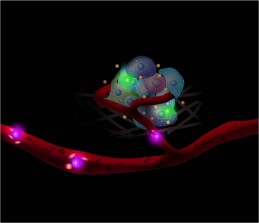Monitoring nanoscale cellular interactions in real time
July 20, 2011
Using nanotechnology to engineer sensors onto the surface of individual cells, researchers at Brigham and Women’s Hospital (BWH) have developed a platform technology for real-time monitoring of single-cell interactions.
The cell-signaling sensors researchers currently use are limited to measuring the activity in the bulk environment that a group of cells are in. “We can now monitor how individual cells talk to one another in real time, with unprecedented spatial and temporal resolution,” said Jeffrey Karp, senior study author and co-director of the Center for Regenerative Therapeutics (ReGen Rx) at BWH.
The researchers said that the cellular sensors provide the ability to further understand complex cell biology, track transplanted cells, and develop effective therapeutics. For example, this would be useful for developing a deeper understanding of signaling events that define a site of inflammation, or the stem cell niche, which may have implications for treatment of many diseases.
“This new study takes a significant step toward the goal to eavesdrop in real time and at high spatial resolution on communications between cells in their native environment, with far-reaching implications for the development of new drugs and diagnostics” said Ulrich von Andrian, the Mallinckrodt Professor of Immunopathology at Harvard Medical School, who was not involved in this study.
Ref.: Weian Zhao, et al., Cell-surface sensors for real-time probing of cellular environments, Nature Nanotechnology, 2011; [DOI: 10.1038/nnano.2011.101]
